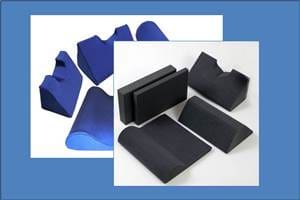statFor some women, it's about making an elegantement at special events or being a couple…

What Are Spinal Molding Blocks and What Do They Do?
 “Spinal molding blocks are one of the basic tools we use as part of a posture correction or curve rehabilitation program. While they may look like simple pieces of foam padding, their job is an important one.”
“Spinal molding blocks are one of the basic tools we use as part of a posture correction or curve rehabilitation program. While they may look like simple pieces of foam padding, their job is an important one.”
“They provide a fulcrum-like support system that your chiropractor can use to gradually “re-mold” or “remodel” the spine (including its supporting musculature and connective tissue) in order to restore its proper curvature.”
Background: An Epidemic of Poor Posture Leading to an Epidemic of Back Pain
Chronic back and neck pain are among the most common musculoskeletal problems treated by healthcare professionals around the world today. Some international health organizations and media outlets have even described the situation as a “global back pain epidemic.” The symptoms can range from uncomfortable and mildly annoying to agonizing and truly debilitating. In most cases, patients’ short-term motivation is to find relief from the pain itself. And—fortunately—chiropractic physicians can often provide the help they’re looking for. Over the years, clinical studies and patient satisfaction surveys have demonstrated that chiropractic care is the most effective treatment for back and neck pain. However, it’s important to understand that relieving the immediate pain is not the same thing as addressing the underlying cause. This is the longer-term goal of chiropractic care.
So what is the underlying cause of chronic back and neck pain? Clearly, there’s no one, simple answer to this question. Some pain may be the lingering result of earlier injuries, while other pain may be related to specific health conditions such as osteoarthritis or advanced spinal disc degeneration. But medical researchers and clinicians have begun to notice an alarming pattern. Much of our neck and back pain can be traced to our modern lifestyle habits—specific things about the way we work, play and even sleep. There is growing evidence that what’s really behind the epidemic of back and neck pain is another epidemic altogether. We spend too much time sitting—at the office, in the car and on the sofa—and too much time looking at screens. And we don’t spend enough time exercising the muscles that help support our frame. Plus, we’re getting heavier at the same time. What we really have is an epidemic of poor posture that, many times, is resulting in a loss of the normal spinal curvature.
Posture Rehabilitation and Spinal Molding Blocks
When it comes to poor posture, there are really only two conversations we can have with patients. The first is about prevention and the second is about treatment and correction. Spinal molding blocks are a part of that second conversation. Spinal molding blocks are one of the basic tools we use as part of a posture correction or curve rehabilitation program. While they may look like simple pieces of foam padding, their job is an important one. They provide a fulcrum-like support system that your chiropractor can use to gradually “re-mold” or “remodel” the spine (including its supporting musculature and connective tissue) in order to restore its proper curvature. Here are just a few examples of the many ways they can be used:
- For full neck and back support – With the patient lying on his or her back, the cervical traction block is placed under the neck. The slanted side of this block should be supporting the head. The block designed for lumbar support goes under the small of the back – or the lumbar area – in order to improve lumbar curve and allow it to relax. The wedge block should be placed under the pelvis so that it “flattens” the lower back and helps improve poor pelvic tilt.
- For neck and lumbar support – The cervical traction block should be placed under the neck so that the slanted side is providing support for the head. The lumbar block should be placed in the lumbar area at the small of the back to improve lumbar curvature.
- For neck-only support – Simply place the cervical traction block under the neck with the slanted side providing support for the head.
- There are many other combinations that can be used depending on the blocks that are available to the chiropractic physician. But the general goal is always the same. Each combination is designed to supply firm but gentle spinal traction in targeted areas of the patient’s back and neck.
Lifestyle Changes and Strengthening Exercises
Most curve rehabilitation programs will use a combination of combination of chiropractic adjustments, spinal molding blocks and foam rolls to help restore the normal curve. But chiropractic physicians will also work closely with patients to make every-day postural adjustments, strengthen core muscles and increase range of motion. Behavioral modification—building new standing, walking and sitting habits—is an especially important part of curve rehabilitation. So are targeted strengthening exercises that can be performed independently. In order to be successful over the long term, patients must make lasting lifestyle changes that are consistent with in-office therapies. Even the best curve rehabilitation program will fall short if poor posture continues to be the norm at home and at work.
Chiropractors are experts in diagnosing and treating a wide range of musculoskeletal and neurological problems. If you are experiencing back or neck pain, or if you notice problems with your posture, we can help. Just call or visit our office today!
Additional Resources:
Bone and Joint Decade: Burden of Major Musculoskeletal Conditions. http://www.who.int/bulletin/volumes/81/9/Woolf.pdf
Negative Effects of Poor Posture. http://www.livestrong.com/article/31223-negative-effects-poor-posture/
OMG, you’re texting your way to back pain. http://www.cbsnews.com/news/omg-youre-texting-your-way-to-back-pain/
Identifying Incorrect Posture. http://www.spine-health.com/wellness/ergonomics/identifying-incorrect-posture/




